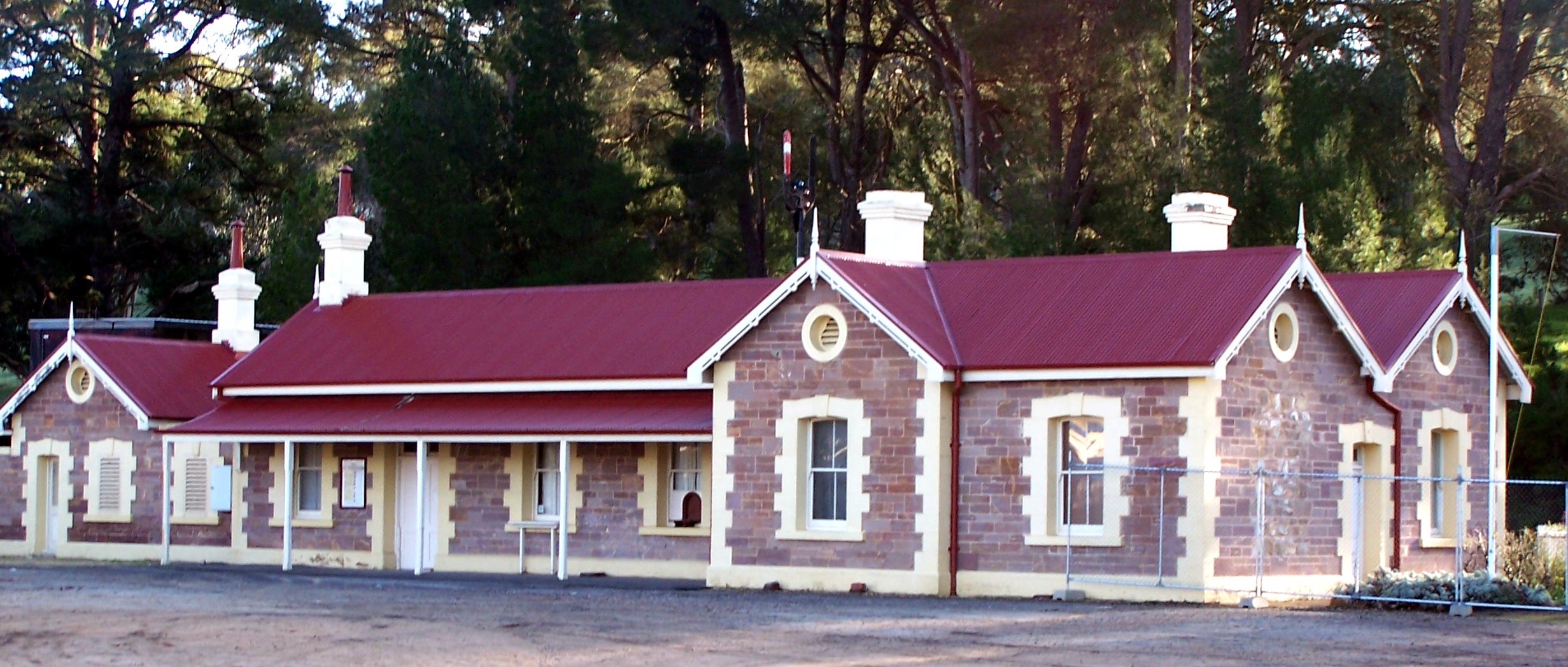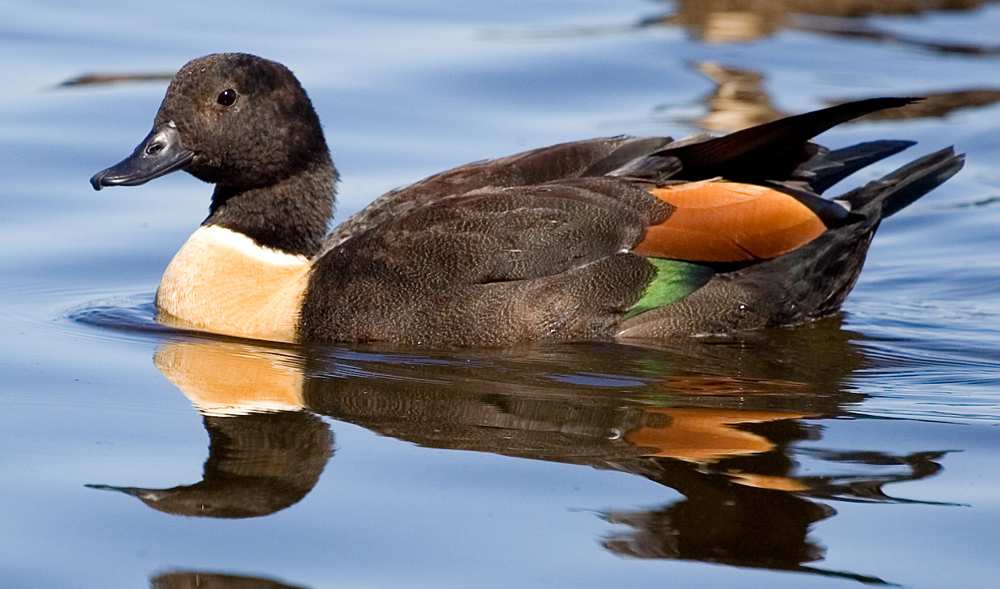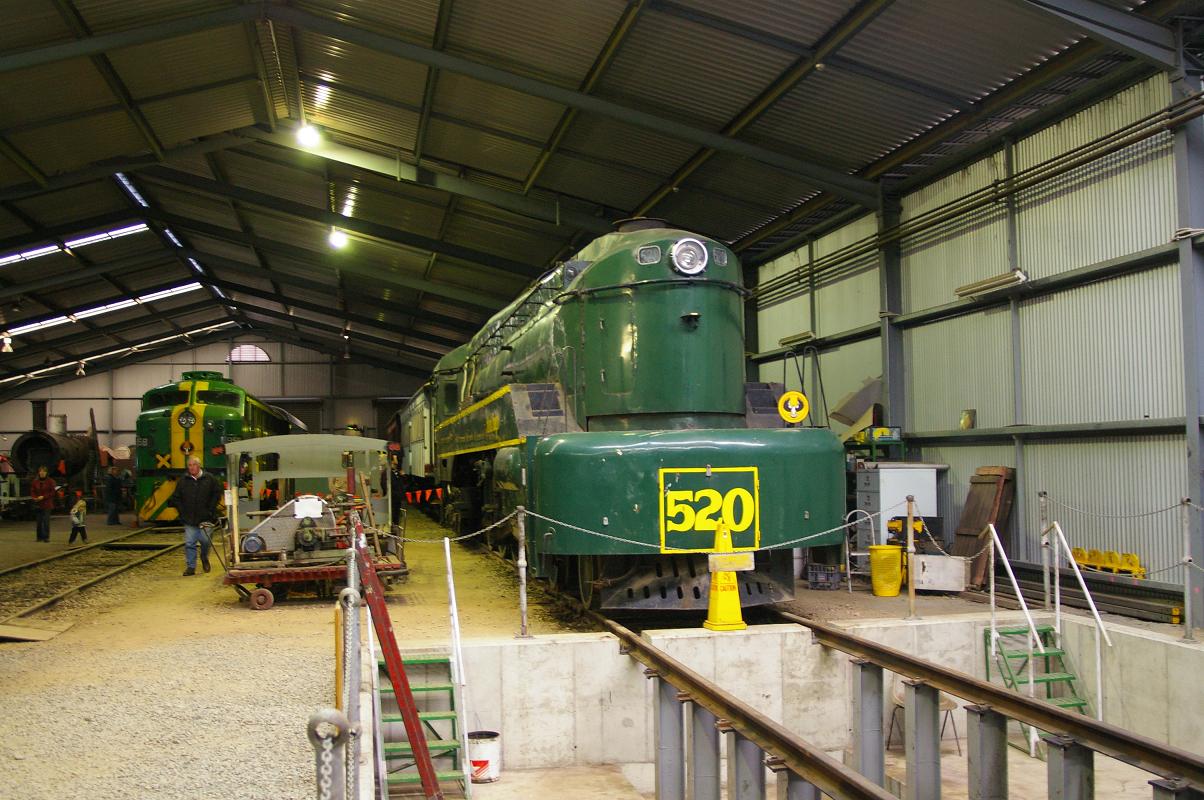|
Nurragi Conservation Reserve
Nurragi was an unattended station at the farming locality of the same name in South Australia. It was located on the former 13.1 km (8.1 mi) long Milang railway line, which opened in 1884 and closed in 1970. The branch line left the former South Australian Railways Mount Barker–Victor Harbor railway line (now the SteamRanger Heritage Railway) at the farming locality of Sandergrove. It ended at Milang, on the shore of Lake Alexandrina. Nurragi, the only intermediate station on the line, was about halfway along the line. The limited facilities were a passing loop A passing loop (UK usage) or passing siding (North America) (also called a crossing loop, crossing place, refuge loop or, colloquially, a hole) is a place on a single line railway or tramway, often located at or near a station, where trains or ... 70 metres (230 yards) long, a full-height platform, and a small shed for local farmers' consignments. The name Nurragi is derived from the word for "sc ... [...More Info...] [...Related Items...] OR: [Wikipedia] [Google] [Baidu] |
Milang Railway Line
The Milang railway line was a branch line, now closed, of the former South Australian Railways that left the mainline to Victor Harbor at the farming locality of Sandergrove, 9 km (6 mi) south of Strathalbyn and 89.7 km (55.75 mi) by rail from Adelaide. From there it proceeded in a south-easterly direction for 13.1 km (8.1 mi) to the riverport of Milang on Lake Alexandrina, in the estuary of the River Murray. The line was opened on 17 December 1884; it was formally closed on 17 June 1970. The route is now a "rail trail" that is popular with hikers. The precincts of the former Milang station house a railway museum that includes an innovative locomotive driving simulator for visitors to operate. Onsite is a centre for South Australian historical light railways. The new river trade During the latter half of the 19th century, many moves and counter-moves, in trade and politics, were prompted by inter-colonial rivalry and fierce competi ... [...More Info...] [...Related Items...] OR: [Wikipedia] [Google] [Baidu] |
South Australian Railways
South Australian Railways (SAR) was the statutory corporation through which the Government of South Australia built and operated railways in South Australia from 1854 until March 1978, when its non-urban railways were incorporated into Australian National, and its Adelaide urban lines were transferred to the State Transport Authority. The SAR had three major rail gauges: 1600 mm (5 ft 3 in); 1435 mm (4 ft in); and 1067 mm (3 ft 6 in). History Colonial period The first railway in South Australia was laid in 1854 between Goolwa and Port Elliot to allow for goods to be transferred between paddle steamers on the Murray River and seagoing vessels. The next railway was laid from the harbour at Port Adelaide, to the capital, Adelaide, and was laid with Irish gauge track. This line was opened in 1856. Later on, branch lines in the state's north in the mining towns of Kapunda and Burra were linked through to the Adelaide metrop ... [...More Info...] [...Related Items...] OR: [Wikipedia] [Google] [Baidu] |
South Australia
South Australia (commonly abbreviated as SA) is a state in the southern central part of Australia. It covers some of the most arid parts of the country. With a total land area of , it is the fourth-largest of Australia's states and territories by area, and second smallest state by population. It has a total of 1.8 million people. Its population is the second most highly centralised in Australia, after Western Australia, with more than 77 percent of South Australians living in the capital Adelaide, or its environs. Other population centres in the state are relatively small; Mount Gambier, the second-largest centre, has a population of 33,233. South Australia shares borders with all of the other mainland states, as well as the Northern Territory; it is bordered to the west by Western Australia, to the north by the Northern Territory, to the north-east by Queensland, to the east by New South Wales, to the south-east by Victoria, and to the south by the Great Australian Bight.M ... [...More Info...] [...Related Items...] OR: [Wikipedia] [Google] [Baidu] |
Nurragi Station Sign (WEA Ramblers Milang-to-nurragi-north-15)
Nurragi was an unattended station at the farming locality of the same name in South Australia. It was located on the former 13.1 km (8.1 mi) long Milang railway line, which opened in 1884 and closed in 1970. The branch line left the former South Australian Railways Mount Barker–Victor Harbor railway line (now the SteamRanger Heritage Railway) at the farming locality of Sandergrove. It ended at Milang, on the shore of Lake Alexandrina. Nurragi, the only intermediate station on the line, was about halfway along the line. The limited facilities were a passing loop 70 metres (230 yards) long, a full-height platform, and a small shed for local farmers' consignments. The name Nurragi is derived from the word for "scrub country" in the language of the local indigenous Ngarrindjeri people. It does indeed describe the original vegetation in the region before more than 98 per cent of it was cleared by European settlers. After the Milang line was closed in 19 ... [...More Info...] [...Related Items...] OR: [Wikipedia] [Google] [Baidu] |
Victor Harbor Railway Line
The Victor Harbor railway line is a broad gauge line in South Australia. It originally branched from the Adelaide to Melbourne line at Mount Barker Junction then ran south to Victor Harbor. When the mainline was converted to standard gauge and the junction was closed, the northern end of the Victor Harbor line was curtailed at Mount Barker, from the junction. History South Australia's first railway venture was the line completed in 1854 from Goolwa, on the River Murray, to the small ocean harbour at Port Elliot. Short trains pulled by horses moved freight and passengers between the shallow-draft River Murray Paddle steamers and coastal and ocean-going vessels, bypassing the narrow, shallow mouth of the river with its unpredictable currents. However, Port Elliot was extremely hazardous; seven vessels had sunk there by 1864. The line was then extended to a safer harbour at Victor Harbor. The Institution of Engineers Australia placed a Historic Engineering Marker on the ... [...More Info...] [...Related Items...] OR: [Wikipedia] [Google] [Baidu] |
SteamRanger Heritage Railway
The SteamRanger Heritage Railway is a long broad gauge tourist railway, formerly the Victor Harbor railway line of the South Australian Railways (SAR). It is operated by the not-for-profit South Australian Division of the Australian Railway Historical Society. As the last operating non-suburban line of the former broad-gauge network, on which Australia's first public railway was opened, the line and its associated rail assets have high historical significance. History In the 1970s, the South Australian Division of the Australian Railway Historical Society established SteamRanger as a not-for-profit railway preservation offshoot to operate its train tours from Adelaide, mainly on rural lines throughout the state's broad gauge networks. SteamRanger opened their first purpose-built depot at Dry Creek railway station, north of Adelaide in 1980. From the mid-1980's, SteamRanger gradually took over the operation & maintenance of the Victor Harbor railway line. When plans were an ... [...More Info...] [...Related Items...] OR: [Wikipedia] [Google] [Baidu] |
Sandergrove, South Australia
Sandergrove is a locality in the Australian state of South Australia about 9 km (5.5 mi) south of Strathalbyn. It was a junction on the Victor Harbor railway line, where the Milang railway line branched off. The railway was authorised in 1881 and closed in 1970. The north-western end of the Nurragi Conservation Reserve, a private protected area which follows the alignment of the former Milang railway line as a rail trail A rail trail is a shared-use path on railway right of way. Rail trails are typically constructed after a railway has been abandoned and the track has been removed, but may also share the right of way with active railways, light rail, or streetcar ..., terminates at Sandergrove. History In 1863, the Strathalbyn Methodist circuit included a church at Sandergrove. It still existed in 1900, but it was not part of the circuit by 1963. The Sandergrove Primary School opened in 1923, but has since closed. References {{authority control Towns in South ... [...More Info...] [...Related Items...] OR: [Wikipedia] [Google] [Baidu] |
Milang, South Australia
Milang ( ) is a town and locality located in the Australian state of South Australia on the west coast of Lake Alexandrina (South Australia), Lake Alexandrina about south-east of the state capital of Adelaide city centre, Adelaide and about north-east of the municipal seat of Goolwa, South Australia, Goolwa. Milang is within the federal division of Mayo, the state electoral district of Hammond and the local government area of the Alexandrina Council. At the 2016 Australian census, 2016 census, the northern part of the locality had a population of 883, of which 761 lived in its town centre. The southern part of Milang shared a population of 69 people with the locality of Point Sturt. The town was surveyed in December 1853; it became a significant port on the River Murray system between 1860 and 1880. Between December 1884 and June 1970, a branch line off the Victor Harbor railway line, Mount Barker–Victor Harbor railway ran 13.1 km (8.1 mi) from a junction at Sande ... [...More Info...] [...Related Items...] OR: [Wikipedia] [Google] [Baidu] |
Lake Alexandrina (South Australia)
Lake Alexandrina is a coastal freshwater lake located between the Fleurieu and Kangaroo Island and Murray and Mallee regions of South Australia, about south-east of Adelaide. The lake adjoins the smaller Lake Albert (together known as the Lower Lakes) and a coastal lagoon called The Coorong to its southeast, before draining into the Great Australian Bight via a short, narrow opening known as Murray Mouth. Nomenclature Aboriginal naming Aboriginal people having an association with the lake were reported as knowing it by such names as ''Mungkuli,'' ''Parnka'' and ''Kayinga.'' European naming English settlers named the lake after Princess Alexandrina, niece and successor of King William IV of Great Britain and Ireland. When the princess ascended the throne and took the name Queen Victoria, there was some talk of changing the name of the lake to Lake Victoria, but the idea was dropped. Description Lake Alexandrina is located north of Encounter Bay and east of Fleurieu Peninsu ... [...More Info...] [...Related Items...] OR: [Wikipedia] [Google] [Baidu] |
SteamRanger
The SteamRanger Heritage Railway is a long broad gauge tourist railway, formerly the Victor Harbor railway line of the South Australian Railways (SAR). It is operated by the not-for-profit South Australian Division of the Australian Railway Historical Society. As the last operating non-suburban line of the former broad-gauge network, on which Australia's first public railway was opened, the line and its associated rail assets have high historical significance. History In the 1970s, the South Australian Division of the Australian Railway Historical Society established SteamRanger as a not-for-profit railway preservation offshoot to operate its train tours from Adelaide, mainly on rural lines throughout the state's broad gauge networks. SteamRanger opened their first purpose-built depot at Dry Creek railway station, north of Adelaide in 1980. From the mid-1980's, SteamRanger gradually took over the operation & maintenance of the Victor Harbor railway line. When plans were an ... [...More Info...] [...Related Items...] OR: [Wikipedia] [Google] [Baidu] |
Nurragi (South Australia) Station Yard Layout Diagram, 1912
Nurragi was an unattended station at the farming locality of the same name in South Australia. It was located on the former 13.1 km (8.1 mi) long Milang railway line, which opened in 1884 and closed in 1970. The branch line left the former South Australian Railways Mount Barker–Victor Harbor railway line (now the SteamRanger Heritage Railway) at the farming locality of Sandergrove. It ended at Milang, on the shore of Lake Alexandrina. Nurragi, the only intermediate station on the line, was about halfway along the line. The limited facilities were a passing loop 70 metres (230 yards) long, a full-height platform, and a small shed for local farmers' consignments. The name Nurragi is derived from the word for "scrub country" in the language of the local indigenous Ngarrindjeri people. It does indeed describe the original vegetation in the region before more than 98 per cent of it was cleared by European settlers. After the Milang line was closed in 19 ... [...More Info...] [...Related Items...] OR: [Wikipedia] [Google] [Baidu] |
Passing Loop
A passing loop (UK usage) or passing siding (North America) (also called a crossing loop, crossing place, refuge loop or, colloquially, a hole) is a place on a single line railway or tramway, often located at or near a station, where trains or trams travelling in opposite directions can pass each other. Trains/trams going in the same direction can also overtake, provided that the signalling arrangement allows it. A passing loop is double-ended and connected to the main track at both ends, though a dead end siding known as a refuge siding, which is much less convenient, can be used. A similar arrangement is used on the gauntlet track of cable railways and funiculars, and in passing places on single-track roads. Ideally, the loop should be longer than all trains needing to cross at that point. Unless the loop is of sufficient length to be dynamic, the first train to arrive must stop or move very slowly, while the second to arrive may pass at speed. If one train is too long for ... [...More Info...] [...Related Items...] OR: [Wikipedia] [Google] [Baidu] |
.jpg)




